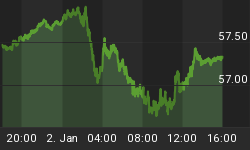Here's a great trivia question for you.
What asset has appreciated more than any asset since the year 2000?
Answer: Farmland. 1,200%
Food prices are skyrocketing all across the globe, and there's no end in sight. The United Nations says food inflation is currently at 30% a year, and the fast-eroding value of the dollar is causing food prices to appear even higher in contrast to a weakening currency. As the dollar drops in value due to runaway money printing at the Federal Reserve, the cost to import foods from other nations looks to double in just the next two years -- and possibly every two years thereafter.
That's probably why investors around the globe are flocking to farmland as the new growth industry. Investors are pouring into farmland in the U.S. and parts of Europe, Latin America and Africa as global food prices soar. A fund controlled by George Soros, the billionaire hedge-fund manager, owns 23.4 percent of a South American farmland venture Adecoagro.
Commodities are still the best play for the long term and legendary investor guru Jim Rogers confessed that he has been buying farmland himself.
People are still going to eat. Mother Nature has taken her wrath out on the world as of late to such an extent that farmers cannot get loans for fertilizers right now without putting their land up as collateral and with too little rain or too much rain the farmland that has been in a family for generations could be wiped away in a trick of fate. Therefore the supplies of food are going to continue to be under pressure. This leads me to conclude that agriculture is going to be one of the greatest industries in the next 20 years, 30 years.
That's because demand for food is accelerating even as radical climate changes, a loss of fossil water supplies, and the failure of genetically engineered crops is actually reducing food yields around the globe. Ceres Partners, which invests in farmland, has produced astonishing 16% annual returns since its launch in 2008. And this is during a depressed economy when most other industries are showing losses.
Ceres partners have investment opportunities for dairy, green house vegetable operations, beef cattle and rice plantations. Ceres reported that most commodity exporting countries of South America are facing highly favorable conditions, particularly those with stronger fundamentals who have easiest access to external financing and stand to benefit the most from low global interest rates. Foreign direct investment in the economies of the region increased almost 20% during 2010 compared to the same period a year ago.
The region's economy expanded 6% in 2010 and according to ECLAC's latest report; South America will grow 5.1% in 2011. In terms of countries, the fastest growing this year will be Argentina (8.3%), Peru (7.1%). Uruguay (6.8%), Ecuador (6.4%), Chile (6.3%), Paraguay (5.7%) followed by Colombia (5.3%), Venezuela (4.5%) and Brazil (4%).
For its soils and weather conditions, abundance of natural resources, good infrastructure and the unique possibility of acquiring large extension of productive farmland; South America is indeed worldwide considered a top place to buy, lease and manage agricultural lands for profit. The region accounts for 59% of global exports of oil seeds, 11% of grains and 37% of meat; with Argentina, Brazil, Chile and Uruguay being among the top 10 food exporters.
Before I take my leave as long as we're talking about commodities to own I would be remiss if I didn't mention Gold and silver. I own some gold and silver and if correct down, I hope I'm smart enough to buy more. The IMF is trying to sell their gold and if they do then they'll drive the price of gold down and that may well be the last opportunity to buy gold for a long time. While I spent a good portion of this essay on farmland I would still encourage my readers to buy on any pullbacks physical coins and buy ETFs like GLD, PHYS, IAU, UGL, SLV, PSLV, AGQ or you can buy mining companies (even though they have lagged the physical and the ETF's) because I believe that people are human and would rather own the metal above the ground that they can hold rather than own great wealth beneath the ground.
A reader asked me if I feared the correction in commodity prices. I told him that's exactly when you're supposed to buy. Corrections are not to be feared but rather expected and embraced.
















